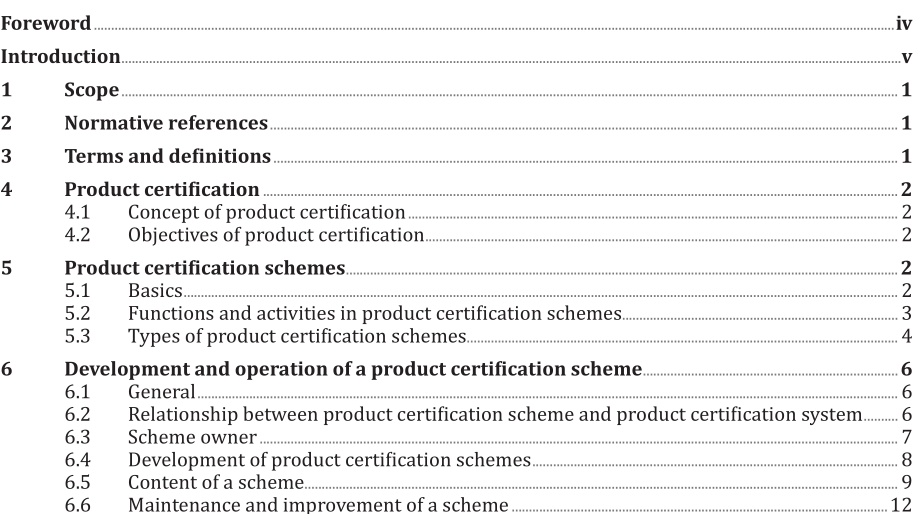ISO IEC 17067-2013 pdf Conformity assessment — Fundamentals of product certification and guidelines for product certification schemes

4 Product certification 4.1 Concept of product certification 4.1.1 Product certification is the provision of assessment and impartial third-party attestation that fulfilment of specified requirements has been demonstrated. Product certification is carried out by product certification bodies which should conform to ISO/IEC 17065. Specified requirements for products are generally contained in standards or other normative documents. 4.1.2 Product certification is an established conformity assessment activity that provides confidence to consumers, regulators, industry and other interested parties that products conform to specified requirements, including for example product performance, safety, interoperability and sustainability. 4.1.3 Product certification can facilitate trade, market access, fair competition and consumer acceptance of products on a national, regional and international level. 4.2 Objectives of product certification 4.2.1 The fundamental objectives of product certification are: a) to address the needs of consumers, users and, more generally, all interested parties by giving confidence regarding fulfilment of specified requirements; b) to allow suppliers to demonstrate to the market that their product has been attested to fulfil specified requirements by an impartial third party body.
5.3.2 Scheme type 1a In this scheme, one or more samples of the product are subjected to the determination activities. A certificate of conformity or other statement of conformity (e.g. a letter) is issued for the product type, the characteristics of which are detailed in the certificate or a document referred to in the certificate. Subsequent production items are not covered by the certification body’s attestation of conformity. The samples are representative of subsequent production items which could be referred to by the manufacturer as being manufactured in accordance with the certified type. The certification body may grant to the manufacturer the right to use the type certificate or other statement of conformity (e.g. letter) as a basis for the manufacturer to declare that subsequent production items conform to the specified requirements. 5.3.3 Scheme type 1b This scheme type involves the certification of a whole batch of products, following selection and determination as specified in the scheme. The proportion to be tested, which can include testing of all the units in the batch (100% testing), would be based, for example, on the homogeneity of the items in the batch and the application of a sampling plan, where appropriate. If the outcome of the determination, review and decision is positive, all items in the batch may be described as certified and may have a mark of conformity affixed, if that is included in the scheme. 5.3.4 Scheme type 2 The surveillance part of this scheme involves periodically taking samples of the product from the market and subjecting them to determination activities to check that items produced subsequent to the initial attestation fulfil the specified requirements. While this scheme may identify the impact of the distribution channel on conformity, the resources it requires can be extensive. Also, when significant nonconformities are found, effective corrective measures may be limited since the product has already been distributed to the market.
- ISO IEC 27050-4-2021 pdf Information technology — Electronic discovery — Part 4: Technical readiness
- ISO IEC 27036-1-2021 pdf Cybersecurity — Supplier relationships — Part 1: Overview and concepts
- ISO IEC 27013-2021 pdf Information security, cybersecurity and privacy protection — Guidance on the integrated implementation of ISO/IEC 27001 and ISO/IEC 20000-1
- ISO IEC 26580-2021 pdf Software and systems engineering — Methods and tools for the feature- based approach to software and systems product line engineering
- ISO IEC 24735-2021 pdf Information technology — Office equipment — Method for measuring digital copying productivity
- ISO IEC 24711-2021 pdf Information technology — Office equipment — Method for the determination of ink cartridge yield for colour inkjet printers and multi- function devices that contain printer components
- ISO IEC 23544-2021 pdf Information Technology — Data centres — Application Platform Energy Effectiveness (APEE)
- ISO IEC 23510-2021 pdf Information technology — 3D printing and scanning — Framework for an Additive Manufacturing Service Platform (AMSP)
- ISO IEC 23127-1-2021 pdf Information technology — Learning, education, and training — Metadata for facilitators of online learning — Part 1: Framework
- ISO IEC 23126-2021 pdf Information technology for learning, education and training — Ubiquitous learning resource organization and description framework
- IEC 61215-1-2-2021 pdf Terrestrial photovoltaic (PV) modules – Design qualification and type approval – Part 1-2: Special requirements for testing of thin-film Cadmium Telluride (CdTe) based photovoltaic (PV) modules
- IEC 62845-2015 pdf Railway applications – Radio remote control system of traction vehicles for shunting application
- IEC 62620-2014 pdf Secondary cells and batteries containing alkaline or other non-acid electrolytes – Secondary lithium cells and batteries for use in industrial applications
- IEC 60317-20-2013 pdf Specifications for particular types of winding wires – Part 20: Solderable polyurethane enamelled round copper wire, class 155
- IEC 60974-11-2021 pdf Arc welding equipment – Part 11: Electrode holders
- BS ISO IEC 15420-2009 pdf Information technology一 Automatic identification and data capture techniques EAN/UPC bar code symbology specification
- BS ISO IEC 19762.5-2008 pdf Information technology一 Automatic identification and data capture (AIDC) techniques – Harmonized vocabulary Part 5: Locating systems
- BS IEC 60860-2014 pdf Radiation protection instrumentation一 Warning equipment for criticality accidents
- ISO IEC 24735-2021 pdf Information technology — Office equipment — Method for measuring digital copying productivity
- ISO IEC 24711-2021 pdf Information technology — Office equipment — Method for the determination of ink cartridge yield for colour inkjet printers and multi- function devices that contain printer components